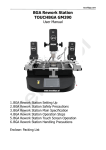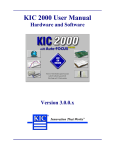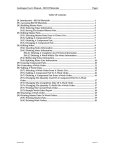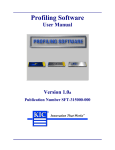Download Optimizing the Recipes in a Dual Lane / Dual
Transcript
Optimizing the Recipes in a Dual Lane / Dual Speed Reflow Oven Using the KIC 2000 Software with KIC Navigator Application Note #20004 Rev: 2011-04 Background Dual speed / dual lane reflow ovens are becoming more popular in the SMT industry in order to save equipment cost and floor space. These ovens are capable of simultaneously reflowing two different PCBs, each with a unique process window. (Alternatively, the ovens may process the same PCB running topside reflow in one track and bottom side reflow in the other track). Recommendations Identifying the correct oven recipes can be difficult and time consuming since the second track needs to use the same zone temperatures selected for the first track reflow. That leaves only conveyor speed as a remaining variable. A KIC profiler along with the KIC 2000 software and KIC Navigator option can be used to quickly and conveniently set up and optimize the recipe settings on a dual track/ dual speed reflow oven. Procedure 1. Identify the appropriate process window for the PCB assembly for Track 1 and enter the data into the KIC 2000 software.(See KIC 2000 User Manual for details on Process Window setup) 2. Attach the TCs to the PCB assembly and run a profile using the KIC profiler following the Run Profile sequence in the software. (See the KIC 2000 User manual for details on Running a Profile) 3. Upon completion of the profile click on the Optimization Tab. AN20004: Optimizing the Recipes in a Dual Lane / Dual Speed Reflow Oven Using the KIC 2000 Software with KIC Navigator Copyright © KIC. All rights reserved. Page 1 of 3 4. Select “Minimize PWI” for the Search Mode, allowing both setpoints and conveyor speed to change. Then click on Apply Changes. The Navigator will now search through thousands of recipe combinations to fine a recipe that will give you an in-spec predicted profile. 5. Enter the suggested oven recipe into the oven. Example of Navigator suggested recipe: 6. Wait for the oven to stabilize and then run a verification profile. If the profile is in spec, continue to step 7. If the profile is not in spec, repeat step 3-6 until an acceptable profile has been found. 7. Perform steps 1-3 on the second PCB for the second track. 8. Once you are on the Optimization tab make sure to deselect “Allow Zone Setpoints to Change” and click on the Apply Changes button. 9. For the predicted recipe the only change will be to the conveyor speed, so once you change to the predicted conveyor speed the oven should be ready to profile. 10. Run a verification profile on Track 2. If this profile is in spec, then the oven is ready to reflow the PCB assemblies in spec for both tracks. 11. If the verification profile is out of spec, select the new suggested conveyor speed and run a verification profile until an acceptable profile has been found. AN20004: Optimizing the Recipes in a Dual Lane / Dual Speed Reflow Oven Using the KIC 2000 Software with KIC Navigator Copyright © KIC. All rights reserved. Page 2 of 3 Worst case scenario: Depending on the thermal capabilities of the reflow oven, it is possible that there is not a new conveyor speed for the second track that puts the profile of the second PCB assembly in spec, using the same zone temperature setpoints from the Track 1 PCB optimized recipe. This situation will require special attention and will require careful consideration by the technician. Essentially the user needs to shift the Track 1 profile to allow the Track 2 profile to get into spec. Use the following steps: 12. Focus on the profile “outliers”. These are the “worst case” PWI numbers highlighted in the KIC Navigator software. Start with Track 1. 13. Then look at Track 2 14. In this example, notice that the track 1 profile has a reflow time on the low side, as is the soak time. In addition, the peak temperature is well within spec. This profile can accommodate more heat and still stay in spec. So the soak and reflow/peak zone temperatures can be increased and still keep the peak temps in spec. So, for example, the zones affecting these profile stats can be raised by 10 C each. This can be done by clicking on the predicted zone setpoint for the zones in the reflow/peak area and manually inputting the temperature. Run another profile to verify that it is in spec. Adjust if required until in spec. 15. With more heat in the oven the KIC Navigator will now have a whole new range of conveyor speeds to work with (faster). Use the new recipe and follow steps 9-12. 16. Select the new conveyor speed suggested by the KIC Navigator for Track 2 and run a verification profile. If the Track 2 profile is in spec, you are ready to run production for both tracks. If track 2 is not in spec yet, please repeat steps 9-12 until both tracks are in spec. Congratulations, you have just accomplished a challenging dual track oven setup in record time using sophisticated process optimization software! Copyright © KIC. All rights reserved. A Division of Embedded Designs Inc. AN20004: Optimizing the Recipes in a Dual Lane / Dual Speed Reflow Oven Using the KIC 2000 Software with KIC Navigator Copyright © KIC. All rights reserved. Page 3 of 3











